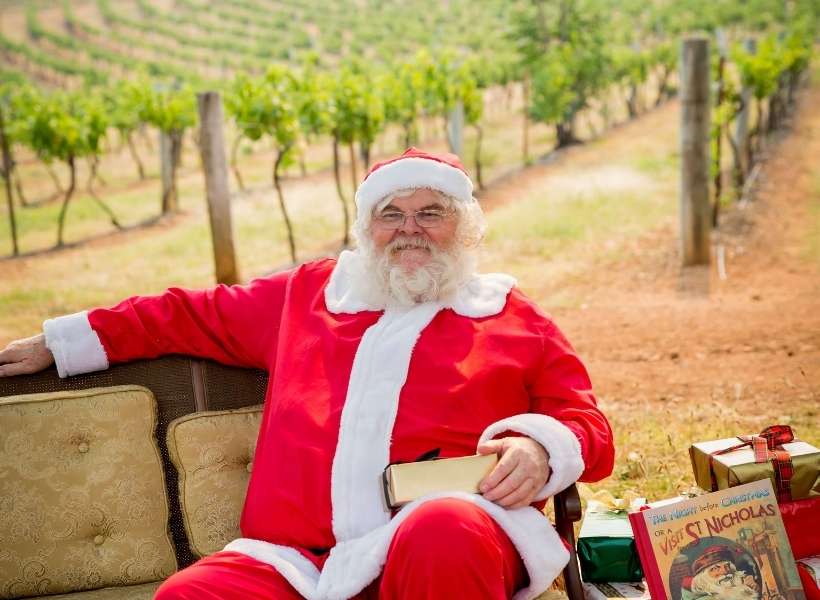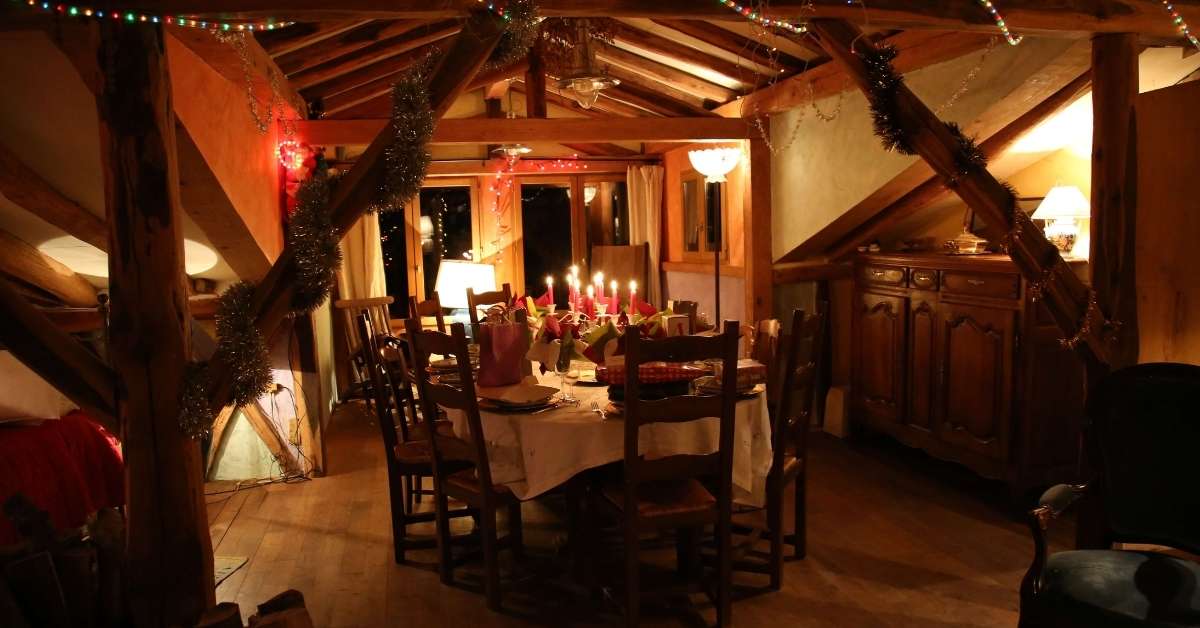This post contains affiliate links, meaning I get a commission if you decide to make a purchase through my links, at no cost to you. Please read my disclosure page for more details.
Category: Christmas in France
Ready to learn about Christmas with a French flavor? In this episode Annie talks about the real story of Christmas as far as French people are concerned.
And because it’s Christmas and we all want a nice giggle, I will also tell you about the French film classic about Christmas called “Le Père Noël est une Ordure”, definitely not your average Christmas movie and I’ll tell you why it’s been such a big hit in France for decades!
Christmas with a French Flavor: Le Père Noël est une ordure
Le Père Noël est une ordure. This movie came out in 1982 and it wasn’t a big hit at first because it is quirky, and I should probably say extremely quirky! But, seeing that it’s one of the few movies about Christmas made in France and it was cheap to buy, TV stations started showing it every year and it grew on us.
American Remake: Mixed Nuts
There is a remake of it called Mixed Nuts with Steve Martin and that one came out in 1994. It’s a similar story line, but not as gritty as the French version. The preview is really funny, it’s on Amazon Prime. It wasn’t popular for a Norah Ephrom film, but we’ll watch it on Christmas day because it seems fitting for 2020!
La Troupe du Splendid
Pere Noel est une ordure is from the same group of folks who brough us Les Bronzés, they were a theater troupe who started making movies and all of them became cult movies. Les Bronzés came out in 1978, Les Bronzés font du Ski in 1979 and Le Père Noël est une Ordure in 1982.
It started out as a play with the same cast and that’s why almost everything in the movie happens in the same room. The actors didn’t think anybody would like this movie because it’s so over the top, but it did! And all the actors in the troupe got extremely popular individually leading to the group splitting up and reuniting only on occasion.
Santa Is a Piece of Garbage
The title Le Père Noël est une Ordure means Santa is a piece of garbage. Can you imagine the big ads in the metro with that title? There are a lot of kids reading the ads in the Paris metro! The RATP refused to advertise it with that title so they toned it down and they advertised it as Les Bronzés Fêtent Noël which is Les Bronzés (the ones who are tanned literally) celebrate Christmas. That was based on their first two movies that had been big hits.
Volunteers at a Suicide Help Line
The premise of the show is a group of people who volunteers at a suicide help line on Christmas Eve. Suicide help lines were brand new in France and there were a lot of ads with the phone number on TV and radio and all that. Christmas movies are typically feel-good but this is a cast of people who are all miserable. Not just the folks who call the suicide help line, they are all miserable and misfits of one sort or another.
Basic Plot of Le Père Noël Est Une Ordure
The movie opens with Pierre is a stuffy, self-righteous volunteer at a telephone helpline for depressed people. He has a well-meaning but naïve co-worker called Thérèse. They are stuck with the Christmas Eve shift in the Paris office and they are not happy about it.
The building's lift is malfunctioning, and they receive visits from unwanted callers: Katia, a depressed transvestite who tries to hit on Pierre, M. Preskovic who lives in the same building and always turns up unexpectedly to offer them various unappetizing pastries and Josette, a heavily pregnant woman on the run from her violent fiancé Félix.
Félix (the violent husband) is working as a Santa Claus during the season and turns up on her trail in costume and brandishing a gun. Félix and Josette, a caricature trailer trash couple, end up struggling over the gun and accidentally shooting dead the lift repairman, whom they then butcher and feed to zoo animals. Cheerful Christmas movie, right?!
Classic Lines
The way classic movies work in France (and anywhere really) is that people memorize some of the lines and use them at opportune moments. One such line is “c’est fin, c’est très fin, ça se mange sans faim » It’s a play on words in French between homonyms “fin” which means fine or delicate and “faim” which means hunger.
The guy who keeps bringing them horrible foods from Hungary brings them Christmas chocolates from his country. They look awful, he tells them they are hand made the traditional way and rolled under the armpit and she says c’est fin, c’est très fin, ça se mange sans faim”. So, we’ve been saying that ever since about anything we don’t want to eat.
Tasteless Jokes
Another joke which they kept in the American version is the guy who calls and says I’m at the end of my rope what shall I do and the woman Josette can’t hear him right and wants him to press a button. So, he pulls the trigger. Dark humor indeed.
There’s the woman who volunteers to make gloves for unfortunate people in India who suffer from leprosy. The Red Cross asked her to make gloves with only 3 fingers and she complains that it would be easier to make mittens. So, Pierre jokes why don’t we just send them socks instead? Ah ah ah very Parisian laugh that makes the rest of France laugh at them and their haughty ways.
But once they’re done laughing, the viewer may understand that they are making fun of well-meaning entitled Parisians who say horrible things because they have no idea about poverty and they are a little bit crazy themselves.
Anyway, I’m not going to tell you the whole story, but this is a definite satire of both well-meaning volunteers and of poor people. Generally speaking in movies, the poor are depicted as good unfortunate folks. In this movie they are jerks! They thieve, lie, and kill. The poor are not nice because they have to fight for their survival.
It’s a crazy story and French people love it! Maybe you would too, just keep in mind that it’s a crazy story that violates a lot of norms and makes us laugh about it.
A Brief History of Christmas
Nicolas de Myra in Turkey was born of wealthy parents called Epiphane and Jeanne in the year 270. They say he stood up in his bath on the day of his birth, which gave them great hope for his future. As an adult he turned away from all entertainment and loved to spend time in churches. He memorized the Holy Books. These were the early days of Christianity where it was spreading from Jerusalem towards Europe and to the East. Many new churches sprung up all over and were the source of great interest everywhere.
We know all this from a book written by an Italian author Jacobus de Varagine who wrote a book called The Golden Legend in the 1200s. His book chronicled the life of saints and martyrs of the Catholic church. Among them was Saint Nicolas whose life can be summarized in one word: generosity.
Having inherited much wealth from his parents Nicolas decided to do good in the world. One day he heard about a poor desperate man in his city had decided to sell his 3 daughters into prostitution so they could all survive. In secret, Nicolas threw gold pieces into the family’s window. But the destitute man saw him and ran to him to express his gratitude. Nicolas made him promise to keep the whole affair a secret.
When the Bishop of Myra died, Nicolas was chosen to become the new Bishop. Despite getting the great honor of becoming a Bishop, Nicolas remained humble and faithful. He also performed several miracles. The most famous is when he saved 3 princes who were visiting from Rome and were the victim of a terrible injustice.
The Golden Legend
We learn from the Golden Legend (the book that chronicles the lives of Saints) that the 3 princes asked for Nicolas’ protection and put themselves under his benevolent care. Nicolas prayed so ardently for the welfare of these princes that he appeared in a dream to the Emperor Constantine the Great asking why these princes were held unjustly.
In the dream Constantine heard him command that he should get up right away and set them free or else he would ask God to bring war to Constantine, a war that would destroy him. Who are you exclaimed Constantine to appear in my palace and dare speak like that? Nicolas replied that he was the humble Bishop of Myra, that’s who.
Setting the Birth of Jesus to December 25th
Let’s stop for one second on Constantine the Great. He was the first Roman Emperor to convert to Christianity. He did it on his death bed, but he was the first. And during his life he made laws to allow his people to worship as they saw fit. He is the one who called the Council of Nicaea in 372 that set many rules for Christianity, Nicolas attended this council.
The purpose of this council was to smooth over the differences between all Christian churches and unite them under one set of beliefs. The credo they wrote was adopted by most Christian churches even if interpretations differed over time. This council is where the date for the birth of Christ was set and they all agreed on December 25th.
At the time it was rare for anyone to celebrate a birthdate. Emperors and Kings did it, but regular people had no idea what day they were born and did not celebrate birthdays. Up until then Easter was the major Christian celebration, it is the holiday that marks the resurrection of Christ.
Christmas Taking Over Saturnalia
Why did they pick December 25th? Because of the established holiday called Saturnalia this was a holiday during which it was forbidden to execute a prisoner or start a war. For Romans, December 25th was the date of the winter solstice. Saturn was a God of agriculture. This was a time period (which lasted a week or so) during which masters could behave like slaves and slaves like master.
It was a time of freedom and celebration when one could speak their minds and be themselves. December 25th was the day of the invincible sun, the day when days start to get longer. OK, we know now that it’s Dec 21st, but let’s cut them some slack.
The Religion of Mithra Loses to Christianity
The religion Mithra-ism was also a major player in the early 300s. This religion came from Persia and was spreading rapidly through Roman soldiers who went all over Europe. Mithra was the divinity of light and truth and the divinity called Mithra was born on December 25th. The birth of Mithra was celebrated by slaughtering a bull and spilling his blood on the ground to bring better harvests.
Mithra-ism was in direct competition with Christianity, but choosing December 25th as both the birth of Christ and the birth of Mithra would bring Jesus forward as the sun of justice and light of the world as decreed by the Council of Nicaea.
So if you’ve heard that Christmas was set in order to celebrate rebirth and fight against pagan rituals, you were correct. But it is more than that. Christmas is an anchor in time that repeats every year, as immutable as the seasons themselves.
Miraculous Oil of Saint Nicolas
Nicolas is said to have died form a fever on December 6, 343. And the amazing news spreads to all his followers: an oil is coming out from the body of the Bishop. It is a magical oil that health all disease. December 6th is now became a holy day marked in the Catholic calendar as Saint Nicolas Day. This is a day when he is worshiped and praised. In 1087 Italian sailors went to Myra and took his reliquary back with them. This increased the importance of worshiping Saint Nicolas.
The God Odin
The stories of Saint Nicolas also coincided with other miraculous events, such as the story of the God Odin in the north of Europe who moved through the air on a horse and wore a long white beard. The Christians in these regions integrated these stories into the story of Christmas where it gained a lot of symbols that are familiar to us today. They also integrated the symbol of the yule log which was a special log you burned for special occasions at the beginning and is now a tree you bring into your home or a cake decorated as a log if you’re French.
The Nativity Scene
Christmas is a sponge for symbolism coming from stories from all over Europe and the Middle East. One more example: the Nativity Scene also started in the Middle Ages with Saint Francis of Assisi who was the founder of the Franciscan order. He introduced the living Nativity scene in churches and that had to get more discrete and was represented as small figurines around the time of the French Revolution because at that time you could get in serious trouble for being overtly religious.
Le Père Fouettard
Saint Nicolas developed a reputation for being the protector of children. He comes down the chimney on Dec 6th to bring gifts to faithful children who left their shoes out to dry near the hearth. And soon in Germany, Saint Nicolas got a side man called Knecht Ruprecht which in France got twisted into Le Père Fouettard who looked like Charles V, the Holy Roman Emperor.
This character appeared in 1522 after the siege of Metz. Père Fouettard, aka the German Emperor, punished unruly and ingrate children. He was supposed to frighten children when Saint Nicolas was all kindness. They traveled together, one taking care of the good kids while the other whipped the bad ones (fouetter means the whip in French).
Dec 25th Wins Over Dec 6th
But in the 1700s the stories of Saint Nicolas came to a sudden stop in much of Europe because protestants didn’t like the worship of saints. But the good Protestant people in Holland decided that they would just hang on to just one Saint. They called him Santa Claus in their language and his feast was celebrated on December 6th. Methinks they had Saint Nicolas in mind, don’t you?
Santa Claus made its way from Holland to New Amsterdam, to be renamed New York later. Many Dutch settled in New Amsterdam in 1625, they brought in their suitcase the tradition of celebrating Santa Claus on December 6th. From there it spread to English settlers of America and many preferred to associate this happy winter celebration with the birth of Jesus than to a Catholic Saint. That’s how Christmas moved to December 25th.
A Visit from Saint Nicolas
Now Santa started delivering his gifts in the night of December 24th instead of December 5th because that didn’t feel so Catholic. In 1823 an American pastor called Clement Clarke Moore, he was an Episcopalian who, as far as I can see seem like the American version of Catholicism or Anglicans. He published a poem anonymously called A Visit from Saint Nicolas also known as Twas the Night Before Christmas.
The story came to him one day as he went shopping using his sleigh which was his usual mode of transportation. He borrowed story elements from a local Dutch handyman as well as the historical Saint Nicolas that he had learned about in Divinity school. He made up the reindeer, but he probably knew about Odin and his magical horse and long white beard.
By the time Moore admitted that he was the author 8 other people had claimed authorship because this was a huge success. People are still arguing about who was the author and I’m in no position to take a side in this hot burning topic.
Drawing Santa
40 years later, a who talented caricaturist called Thomas Nast who also drew Uncle Tom with his tall hat and stripped pants drew Santa who now got rid of his Bishop attire and now wearing a red cape with white trim, a big belly and a wide leather belt. In the same series of drawings he represented two children who follow the path Santa takes between the north pole and the US. Santa as we know him today was born out of the imagination of Thomas Nast and he is definitely a character from the North.
Santa and Coca Cola
This figure became popular all over the western world through advertising. Waterman pens used him in 1907, then Michelin in 1919 and Colgate in 1920. This jolly character was great for advertising products! And the Coca Cola brand refined Santa as we know him today. In 1931 Haddon Sundblom drew himself as the jolly Santa we know today.
A large jolly man dressed in white holding a Coca Cola bottle. I’ll point you to a blog post where you can see all these images in the show notes because I don’t have rights to them. The whole idea was to inspire people to drink Coke in the middle of the winter. Before then Santa was pictured with snacks or cakes, Sundblom changed all that.
French Christmas Traditions
What a long way Santa has come since the early 200s! The reason why this happened is because we all love a wonderful holiday, be it religious or commercial. And a story that comes back around every year gets richer every time it is told.
Of course in France we have our traditions that are different from what I experienced in America. For one thing, I had never seen a glut of gifts the way I did in American families. In France gifts are mostly for children. Grown ups may have one or two gifts, but kids rake in dozens.
In France when there are little kids in the family we don’t put any gifts under the tree, they all get revealed on Christmas Eve or Christmas Morning when someone declares they heard some strange noise in the other room, let’s go see! In my family we sing the old classic Petit Papa Noël to make Santa come. And we don’t use stockings, presents appear next to our shoe.
We also dress a beautiful table. No eating out of disposable anything on Christmas Eve or Christmas Day. What are the foods of Christmas in France? Oysters, foie gras, smoked salmon, duck, turkey, bûche de Noël (which I buy), lots of chocolates, lots of Champagne.
Activities include playing with new toys which these days often include video games, chatting, cooking, drinking, dancing around like fools, you know, same-old, same-old. I wish you all a wonderful Christmas because this holiday has become so big that almost everyone celebrates it all over the world. It’s not about a Catholic Saint so much is it? I’m told they do big celebrations in Asia and in Africa, everywhere really. Christmas by now has become a world-wide feast, and in a year like 2020 we could all use a few days of celebrations!
Paris fined for having too many women in charge: news article.
More episodes about Christmas in France
FOLLOW US ON:
Subscribe to the Podcast
Apple YouTube Spotify RSSSupport the Show
Tip Your Guides Extras Patreon Audio Tours
Category: Christmas in France



